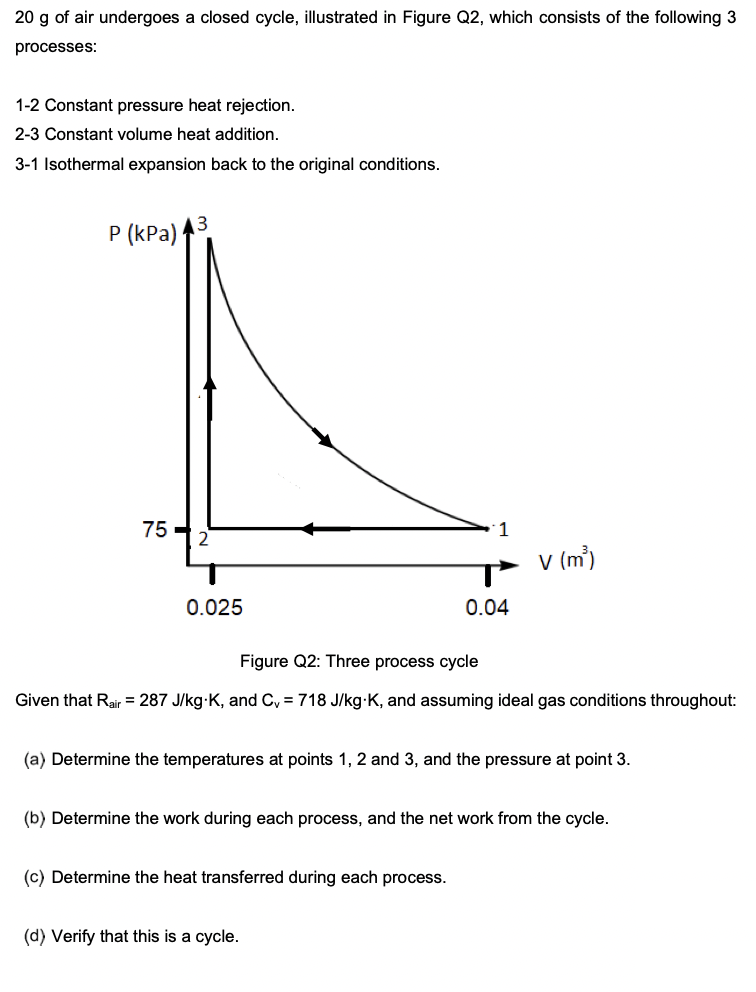processes: 1-2 Constant pressure heat rejection. 2-3 Constant volume heat addition. 3-1 Isothermal expansion back to the original conditions. P (kPa) 13 75 - 2 1 V (m³) 0.025 0.04 Figure Q2: Three process cycle Given that Rair = 287 J/kg K, and C, = 718 J/kg-K, and assuming ideal gas conditions throughout: (a) Determine the temperatures at points 1, 2 and 3, and the pressure at point 3. (b) Determine the work during each process, and the net work from the cycle. (c) Determine the heat transferred during each process. (d) Verify that this is a cycle.
processes: 1-2 Constant pressure heat rejection. 2-3 Constant volume heat addition. 3-1 Isothermal expansion back to the original conditions. P (kPa) 13 75 - 2 1 V (m³) 0.025 0.04 Figure Q2: Three process cycle Given that Rair = 287 J/kg K, and C, = 718 J/kg-K, and assuming ideal gas conditions throughout: (a) Determine the temperatures at points 1, 2 and 3, and the pressure at point 3. (b) Determine the work during each process, and the net work from the cycle. (c) Determine the heat transferred during each process. (d) Verify that this is a cycle.
Elements Of Electromagnetics
7th Edition
ISBN:9780190698614
Author:Sadiku, Matthew N. O.
Publisher:Sadiku, Matthew N. O.
ChapterMA: Math Assessment
Section: Chapter Questions
Problem 1.1MA
Related questions
Question

Transcribed Image Text:20 g of air undergoes a closed cycle, illustrated in Figure Q2, which consists of the following 3
processes:
1-2 Constant pressure heat rejection.
2-3 Constant volume heat addition.
3-1 Isothermal expansion back to the original conditions.
P (kPa)
75
1
V (m')
0.025
0.04
Figure Q2: Three process cycle
Given that Rair = 287 J/kg-K, and Cy = 718 J/kg-K, and assuming ideal gas conditions throughout:
(a) Determine the temperatures at points 1, 2 and 3, and the pressure at point 3.
(b) Determine the work during each process, and the net work from the cycle.
(c) Determine the heat transferred during each process.
(d) Verify that this is a cycle.
Expert Solution
This question has been solved!
Explore an expertly crafted, step-by-step solution for a thorough understanding of key concepts.
Step by step
Solved in 3 steps with 3 images

Knowledge Booster
Learn more about
Need a deep-dive on the concept behind this application? Look no further. Learn more about this topic, mechanical-engineering and related others by exploring similar questions and additional content below.Recommended textbooks for you

Elements Of Electromagnetics
Mechanical Engineering
ISBN:
9780190698614
Author:
Sadiku, Matthew N. O.
Publisher:
Oxford University Press

Mechanics of Materials (10th Edition)
Mechanical Engineering
ISBN:
9780134319650
Author:
Russell C. Hibbeler
Publisher:
PEARSON

Thermodynamics: An Engineering Approach
Mechanical Engineering
ISBN:
9781259822674
Author:
Yunus A. Cengel Dr., Michael A. Boles
Publisher:
McGraw-Hill Education

Elements Of Electromagnetics
Mechanical Engineering
ISBN:
9780190698614
Author:
Sadiku, Matthew N. O.
Publisher:
Oxford University Press

Mechanics of Materials (10th Edition)
Mechanical Engineering
ISBN:
9780134319650
Author:
Russell C. Hibbeler
Publisher:
PEARSON

Thermodynamics: An Engineering Approach
Mechanical Engineering
ISBN:
9781259822674
Author:
Yunus A. Cengel Dr., Michael A. Boles
Publisher:
McGraw-Hill Education

Control Systems Engineering
Mechanical Engineering
ISBN:
9781118170519
Author:
Norman S. Nise
Publisher:
WILEY

Mechanics of Materials (MindTap Course List)
Mechanical Engineering
ISBN:
9781337093347
Author:
Barry J. Goodno, James M. Gere
Publisher:
Cengage Learning

Engineering Mechanics: Statics
Mechanical Engineering
ISBN:
9781118807330
Author:
James L. Meriam, L. G. Kraige, J. N. Bolton
Publisher:
WILEY